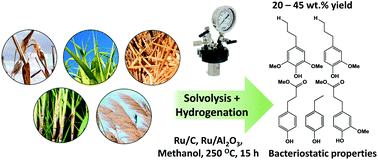Cheap and abundant waste from bioethanol and agricultural processing industries are an alluring alternative feedstock for biorefineries. In this work, we employ reductive catalytic fractionation (RCF) to depolymerize, over Ru/C powder and Ru/Al2O3 pellets, five herbaceous biomass feedstocks, namely corn stover, miscanthus, switchgrass, sugarcane bagasse, and wheat straw into phenolic monomers with high yields (∼40 wt% based on total (Klason + acid soluble) lignin and >50 wt% when stabilized using aldehydes), leaving behind a carbohydrate pulp residue. Interestingly, a polar solvent is sufficient to solubilize and fragment the lignin polymer into monomers without any catalyst. Contrary to woody biomass, where the monomer yields are positively correlated with the S-content of lignin, principal component analysis indicates that the monomer yields from herbaceous biomass depend on the content of lignin crosslinker – ferulate. Using NMR, we further identify α-6 C–C linked oligomers formed from condensation reactions, explaining the unexpected low monomer yields of high β-O-4 herbaceous biomass. Recyclability experiments indicate that catalyst deactivation occurs through sintering, leaching, and fouling. Lignin oil from herbaceous biomass exhibits bacteriostatic effects against Staphylococcus aureus, highlighting a potential application in functional food development and as a food or feed preservative.

